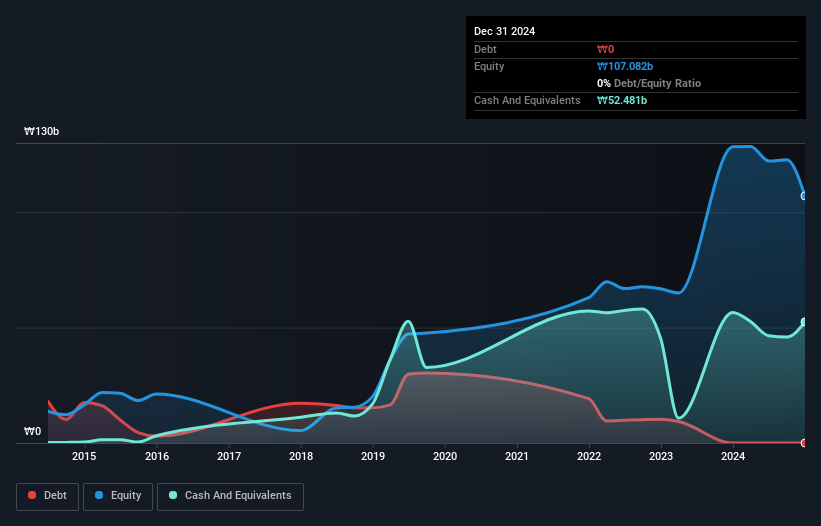- South Korea
- /
- Semiconductors
- /
- KOSDAQ:A038530
Here's Why We're Not At All Concerned With KBIO's (KOSDAQ:038530) Cash Burn Situation
We can readily understand why investors are attracted to unprofitable companies. For example, biotech and mining exploration companies often lose money for years before finding success with a new treatment or mineral discovery. But the harsh reality is that very many loss making companies burn through all their cash and go bankrupt.
So should KBIO (KOSDAQ:038530) shareholders be worried about its cash burn? For the purposes of this article, cash burn is the annual rate at which an unprofitable company spends cash to fund its growth; its negative free cash flow. Let's start with an examination of the business' cash, relative to its cash burn.
When Might KBIO Run Out Of Money?
A company's cash runway is the amount of time it would take to burn through its cash reserves at its current cash burn rate. As at December 2024, KBIO had cash of ₩52b and no debt. Looking at the last year, the company burnt through ₩190m. So it had a very long cash runway of many years from December 2024. Even though this is but one measure of the company's cash burn, the thought of such a long cash runway warms our bellies in a comforting way. Depicted below, you can see how its cash holdings have changed over time.

See our latest analysis for KBIO
How Well Is KBIO Growing?
Given our focus on KBIO's cash burn, we're delighted to see that it reduced its cash burn by a nifty 86%. And it is also great to see that the revenue is up a stonking 180% in the same time period. Overall, we'd say its growth is rather impressive. In reality, this article only makes a short study of the company's growth data. This graph of historic revenue growth shows how KBIO is building its business over time.
How Easily Can KBIO Raise Cash?
While KBIO seems to be in a decent position, we reckon it is still worth thinking about how easily it could raise more cash, if that proved desirable. Generally speaking, a listed business can raise new cash through issuing shares or taking on debt. One of the main advantages held by publicly listed companies is that they can sell shares to investors to raise cash and fund growth. By comparing a company's annual cash burn to its total market capitalisation, we can estimate roughly how many shares it would have to issue in order to run the company for another year (at the same burn rate).
KBIO's cash burn of ₩190m is about 0.6% of its ₩31b market capitalisation. So it could almost certainly just borrow a little to fund another year's growth, or else easily raise the cash by issuing a few shares.
So, Should We Worry About KBIO's Cash Burn?
It may already be apparent to you that we're relatively comfortable with the way KBIO is burning through its cash. In particular, we think its cash burn reduction stands out as evidence that the company is well on top of its spending. But it's fair to say that its cash burn relative to its market cap was also very reassuring. Taking all the factors in this report into account, we're not at all worried about its cash burn, as the business appears well capitalized to spend as needs be. An in-depth examination of risks revealed 1 warning sign for KBIO that readers should think about before committing capital to this stock.
Of course, you might find a fantastic investment by looking elsewhere. So take a peek at this free list of companies with significant insider holdings, and this list of stocks growth stocks (according to analyst forecasts)
Valuation is complex, but we're here to simplify it.
Discover if KBIO might be undervalued or overvalued with our detailed analysis, featuring fair value estimates, potential risks, dividends, insider trades, and its financial condition.
Access Free AnalysisHave feedback on this article? Concerned about the content? Get in touch with us directly. Alternatively, email editorial-team (at) simplywallst.com.
This article by Simply Wall St is general in nature. We provide commentary based on historical data and analyst forecasts only using an unbiased methodology and our articles are not intended to be financial advice. It does not constitute a recommendation to buy or sell any stock, and does not take account of your objectives, or your financial situation. We aim to bring you long-term focused analysis driven by fundamental data. Note that our analysis may not factor in the latest price-sensitive company announcements or qualitative material. Simply Wall St has no position in any stocks mentioned.
About KOSDAQ:A038530
Flawless balance sheet and good value.
Market Insights
Community Narratives



